Why pedestrian safety clothing may confuse automated crash prevention systems
Share
Share

A new study is warning about the risk of reflective clothing and a vehicle’s crash prevention systems.
The report from the Insurance Institute for Highway Safety (IIHS) suggested that the clothing designed to make pedestrians stand out to human drivers may actually make them invisible to automated systems.
“These results suggest that some automakers need to tweak their pedestrian automatic emergency braking systems,” said IIHS president David Harkey. “It’s untenable that the clothes that pedestrians, cyclists and roadway workers wear to be safe may make them harder for crash avoidance technology to recognize.”
Past IIHS research has shown that pedestrian automatic emergency braking (AEB) systems generally reduce the rate of pedestrian crashes by 27 per cent. However, on dark roads, the effect of pedestrian AEB on crash risk is negligible, which is concerning since most fatal pedestrian crashes occur at night. Automakers are already working to address this issue in response to IIHS ratings that now emphasize nighttime performance, but real-world factors complicate the situation.
The new study examined the effects of conspicuous clothing and increased roadway lighting on the performance of pedestrian AEB systems in three 2023 models: a Honda CR-V, Mazda CX-5, and Subaru Forester. Researchers conducted multiple trials with an adult-sized dummy dressed in various outfits, including a black sweatshirt and pants, a retroreflective jacket with black sweatpants, black clothing with retroreflective strips on the limbs and joints, and a white sweatshirt and pants. The tests were run at 25 mph with different levels of roadway lighting.
The CR-V and CX-5 hit the dummy in 84 per cent and 88 per cent of the test runs, respectively, while the Forester avoided a collision in all but one trial. Neither the CR-V nor CX-5 slowed at all when the dummy wore clothing with reflective strips. When the dummy was dressed in black, both vehicles slowed substantially when using their high beams but performed poorly with low beams. Both vehicles did better with 20 lux of additional light.
When the dummy wore the reflective jacket, the CR-V didn’t slow in any trials, regardless of additional lighting. The CX-5 slowed more with 10 lux of added light but performed worse with 20 lux. When the dummy was dressed in white, the CR-V performed best with 10 and 20 lux of added light, while the CX-5 performed better than with the dummy in black but not as well as with the reflective jacket.
The Subaru Forester performed the best overall, coming to a complete stop in every trial except one, where it slowed by more than 80 per cent.
“The placement and motion of reflective strips on the joints and limbs of pants and jackets allows drivers to quickly recognize the pattern of movement as a person,” said study author David Kidd. “Unfortunately, the moving strips didn’t have the same effect for the pedestrian AEB systems we tested and probably confounded their sensors.”
The study raises concerns about the effectiveness of pedestrian detection systems, especially for roadway workers and emergency personnel who use similar garments. IIHS noted that Further research is needed to determine how these systems respond to specific safety equipment used by such workers. “This is a worrisome blind spot,” Harkey said. “To make good on their potential, pedestrian detection systems have to work with the other commonly used safety measures.”
Image credit: Depositphotos.com
Leave a Reply